
Algae are any of a large and diverse group of photosynthetic, eukaryotic organisms. The name is an informal term for a polyphyletic grouping that includes species from multiple distinct clades. Included organisms range from unicellular microalgae, such as Chlorella, Prototheca and the diatoms, to multicellular forms, such as the giant kelp, a large brown alga which may grow up to 50 metres (160 ft) in length. Most are aquatic and lack many of the distinct cell and tissue types, such as stomata, xylem and phloem that are found in land plants. The largest and most complex marine algae are called seaweeds, while the most complex freshwater forms are the Charophyta, a division of green algae which includes, for example, Spirogyra and stoneworts. Algae that are carried by water are plankton, specifically phytoplankton.

Brown algae are a large group of multicellular algae comprising the class Phaeophyceae. They include many seaweeds located in colder waters of the Northern Hemisphere. Brown algae are the major seaweeds of the temperate and polar regions. Many brown algae, such as members of the order Fucales, commonly grow along rocky seashores. Most brown algae live in marine environments, where they play an important role both as food and as a potential habitat. For instance, Macrocystis, a kelp of the order Laminariales, may reach 60 m (200 ft) in length and forms prominent underwater kelp forests that contain a high level of biodiversity. Another example is Sargassum, which creates unique floating mats of seaweed in the tropical waters of the Sargasso Sea that serve as the habitats for many species. Some members of the class, such as kelps, are used by humans as food.
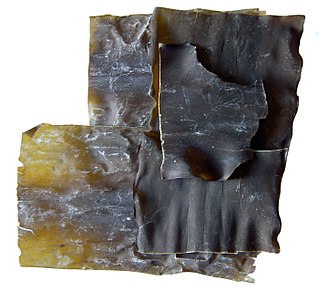
Konbu is edible kelp mostly from the family Laminariaceae and is widely eaten in East Asia. It may also be referred to as dasima or haidai.

Wakame(Undaria pinnatifida) is a species of kelp native to cold, temperate coasts of the northwest Pacific Ocean. As an edible seaweed, it has a subtly sweet, but distinctive and strong flavour and satiny texture. It is most often served in soups and salads.

Sargassum is a genus of brown macroalgae (seaweed) in the order Fucales of the Phaeophyceae class. Numerous species are distributed throughout the temperate and tropical oceans of the world, where they generally inhabit shallow water and coral reefs, and the genus is widely known for its planktonic (free-floating) species. Most species within the class Phaeophyceae are predominantly cold-water organisms that benefit from nutrients upwelling, but the genus Sargassum appears to be an exception. Any number of the normally benthic species may take on a planktonic, often pelagic existence after being removed from reefs during rough weather. Two species have become holopelagic—reproducing vegetatively and never attaching to the seafloor during their lifecycles. The Atlantic Ocean's Sargasso Sea was named after the algae, as it hosts a large amount of Sargassum.
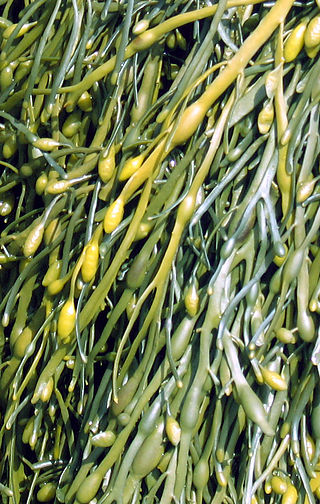
Ascophyllum nodosum is a large, common cold water seaweed or brown alga (Phaeophyceae) in the family Fucaceae. Its common names include knotted wrack, egg wrack, feamainn bhuí, rockweed, knotted kelp and Norwegian kelp. It grows only in the northern Atlantic Ocean, along the north-western coast of Europe including east Greenland and the north-eastern coast of North America. Its range further south of these latitudes is limited by warmer ocean waters. It dominates the intertidal zone. Ascophyllum nodosum has been used numerous times in scientific research and has even been found to benefit humans through consumption.
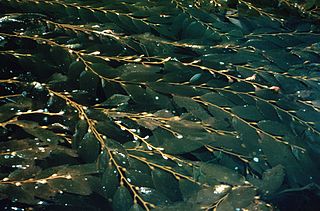
Macrocystis is a monospecific genus of kelp with all species now synonymous with Macrocystis pyrifera. It is commonly known as giant kelp or bladder kelp. This genus contains the largest of all the Phaeophyceae or brown algae. Macrocystis has pneumatocysts at the base of its blades. Sporophytes are perennial and the individual may live for up to three years; stipes/fronds within a whole individual undergo senescence, where each frond may persist for approximately 100 days. The genus is found widely in subtropical, temperate, and sub-Antarctic oceans of the Southern Hemisphere and in the northeast Pacific from Baja California to Sitka, Alaska. Macrocystis is often a major component of temperate kelp forests.

Desmarestiales is an order in the brown algae (Phaeophyceae). Members of this order have terete or ligulate (flat) pinnately branched thalli attached by discoid holdfasts. They have a sporphytic thallus usually aggregated to form a pseudo-parenchyma. The order gets its name from the genus Desmarestia, which is named after the French zoologist Anselme Gaëtan Desmarest (1784–1838).
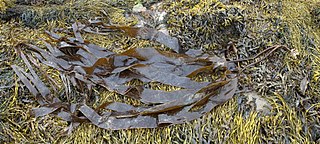
Laminaria digitata is a large brown alga in the family Laminariaceae, also known by the common name oarweed. It is found in the sublittoral zone of the northern Atlantic Ocean.

Edible seaweed, or sea vegetables, are seaweeds that can be eaten and used for culinary purposes. They typically contain high amounts of fiber. They may belong to one of several groups of multicellular algae: the red algae, green algae, and brown algae. Seaweeds are also harvested or cultivated for the extraction of polysaccharides such as alginate, agar and carrageenan, gelatinous substances collectively known as hydrocolloids or phycocolloids. Hydrocolloids have attained commercial significance, especially in food production as food additives. The food industry exploits the gelling, water-retention, emulsifying and other physical properties of these hydrocolloids.
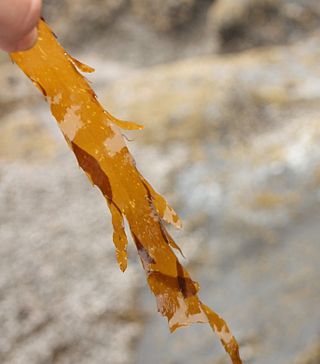
Desmarestiaceae is a family of brown algae, one of two families in the order Desmarestiales. The family gets its name from the genus Desmarestia, which is named after the French zoologist Anselme Gaëtan Desmarest (1784-1838).

Desmarestia is a genus of brown algae found worldwide. It is also called acid weed, acidweed, oseille de mer, sea sorrel, ウルシグサ, stacheltang, mermaid's hair, landlady's wig, or gruagach. However, 'sea sorrel' can also specifically refer to Desmarestia viridis. Members of this genus can be either annual or perennial. Annual members of this genus store sulfuric acid in intracellular vacuoles. When exposed to air they release the acid, thereby destroying themselves and nearby seaweeds in the process. They are found in shallow intertidal zones.

Wendy Alison Nelson is a New Zealand marine scientist and world expert in phycology. She is New Zealand's leading authority on seaweeds. Nelson is particularly interested in the biosystematics of seaweeds/macroalgae of New Zealand, with research on floristics, evolution and phylogeny, as well as ecology, and life history studies of marine algae. Recently she has worked on the systematics and biology of red algae including coralline algae, distribution and diversity of seaweeds in harbours and soft sediment habitats, and seaweeds of the Ross Sea and Balleny Islands.

Chaetocoelopa littoralis, commonly known as the hairy kelp fly, is a fly of the family Coelopidae. It is endemic to New Zealand and is widely distributed around the coastline, including offshore islands. These flies are black in appearance and show large variation in size, with males tending to be larger and more robust and 'hairy' than females.

Desmarestia tropica, sometimes called tropical acidweed, is a species of seaweed in the family Desmarestiaceae. It is critically endangered, possibly extinct, and one of only fifteen protists evaluated by IUCN. Endemic to the Galápagos Islands, the specific epithet tropica alludes to its tropical habitat, rare for members of Desmarestiales. The common name acidweed applies to members of the genus Desmarestia, generally characterized by fronds containing vacuoles of concentrated sulfuric acid, but it is unclear if this species also produces acid.

Desmarestia aculeata is a species of brown algae found worldwide. Its common names include color changer, Desmarest's flattened weed, and sea sorrel, though the last name can refer to other species of Desmarestia.
Pseudo-nitzschia australis is a pennate diatom found in temperate and sub-tropic marine waters, such as off the coast of California and Argentina. This diatom is a Harmful Micro Algae that produces toxic effects on a variety of organisms through its production of domoic acid, a neurotoxin. Toxic effects have been observed in a variety of predatory organisms such as pelicans, sea lions, and humans. If exposed to a high enough dose, these predators will die as a result, and there is no known antidote. The potential indirect mortality associated with P. australis is of great concern to humans as toxic algae blooms, including blooms of P. australis, continue to increase in frequency and severity over recent years. Blooms of P. australis are believed to result from high concentrations of nitrates and phosphates in stream and river runoff, as well as coastal upwelling, which are also sources of other harmful algae blooms.
Seaweed fertiliser is organic fertilizer made from seaweed that is used in agriculture to increase soil fertility and plant growth. The use of seaweed fertilizer dates back to antiquity and has a broad array of benefits for soils. Seaweed fertilizer can be applied in a number of different forms, including refined liquid extracts and dried, pulverized organic material. Through its composition of various bioactive molecules, seaweed functions as a strong soil conditioner, bio-remediator, and biological pest control, with each seaweed phylum offering various benefits to soil and crop health. These benefits can include increased tolerance to abiotic stressors, improved soil texture and water retention, and reduced occurrence of diseases.
Mary Wyatt (1789–1871) was a British botanist, phycologist and retailer from Torquay, Devon. She was the compiler of the respected Algae Danmoniensis - a collection, i.e. exsiccata, of seaweeds to which William Henry Harvey later considered his Manual of the British Algae (1841) a 'companion' work. Wyatt helped to fuel the Victorian 'seaweed craze' for collecting. The tongue twister 'She Sells Seashells on the Sea Shore' was possibly inspired by Wyatt and her close companion Amelia Griffiths, with whom she collected seaweed and sea shells in Devon.
















